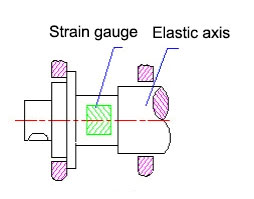How Does a Torque Sensor Work?
Torque sensors, also known as torque sensors, torque sensors, torque transducers, or torque meters, are divided into two categories: dynamic and static, of which dynamic torque sensors can be called torque sensors, torque speed sensors, non-contact torque sensors, rotating torque sensors and so on. Torque sensors are used to detect the perception of torsional moments on a variety of rotating or non-rotating mechanical components. ATO online shop will explain in detail how torque sensors work in this article.
Basic Introduction
Torque sensors convert physical changes in torque into a precise electrical signal. Torque sensors can be used in the manufacture of viscometers, and electric (pneumatic, hydraulic) torque wrenches, which have the advantages of high accuracy, fast frequency response, good reliability, and long life. Often referred to as torque is the external torque, such as machine tool spindle rotation is the power source to provide the results of the role of the external torque, while the torque is the internal torque, spindle work, tool cutting force on the spindle of the reaction to the spindle torsional elastic deformation can be used to measure the size of the torque. Torque is the moment of force that causes an object to undergo a rotational effect or torsional deformation, and is equal to the product of the force and the force arm.

Basic Principle of Torque Sensor
The basic principle of a torque sensor is to utilize the elastic deformation of a material or other physical effects to measure torque. The following are some common torque sensor operating principles.
Strain Gauge Technology: Strain gauge technology is one of the most widely used principles in torque sensors. The shaft portion of the sensor is fitted with strain gauges. When subjected to torque, the shaft deforms elastically, causing the strain gauges to deform. This deformation causes a change in the resistance of the strain gauge, and the amount of torque can be determined by measuring the change in resistance.
Magnetic Technology: Magnetic technology utilizes changes in the magnetic field to measure torque. The torque sensor contains a magnetically sensitive material, and when subjected to torque, the magnetic field changes. By measuring the change in the magnetic field, the torque applied to the sensor can be calculated.
Optical Technology: Optical technology uses an optical sensor to measure torque. Some torque sensors contain optical elements that change shape or position when subjected to torque. By measuring these changes, the amount of torque can be determined.
Measurement Principle
- Measurement of Torque: Strain gauge electrodynamics is used to form a strain bridge over an elastic shaft.
- The signal output can be arbitrarily selected waveform-square wave or pulse wave.
- High detection accuracy, good stability, and strong anti-interference.
- No need to adjust the zero can be, a continuous measurement of positive and negative torque.
- It can measure static torque and dynamic torque.
- Small volume, heavy sensors can be used independently from the secondary instrumentation, as long as the socket PIN provides +15V, -15V (200mA) power supply, you can output impedance, and torque is proportional to the square wave or pulse wave frequency signal. Lightweight and easy to install.
- Measuring Range: 0-10000Nm standard optional, non-standard 20,000Nm, 30,000Nm, 50,000Nm, 80,000Nm, 100,000Nm, special range can be customized.
Signal Transmission
Square wave signal, pulse signal. The standard signal output of high quality torque transducer is frequency signal, i.e. 5-15KHz, to adapt to the customer's demand, no external module is needed, and the original output circuit is integrated and designed to output 4-20mA, 0-20mA, 1-5V, 0-5V analog signals directly, which is convenient for customers to pick.
Torque Signal Processing Form: The torque sensor outputs a frequency signal to the frequency meter or digital meter, directly read with the torque proportional to the frequency signal or voltage, current signal. The torque and frequency signals from the torque sensor are sent to the microcontroller secondary instrument, which directly displays the real-time torque value, rotational speed output power value, and RS232 communication signal. The torque and speed frequency signals are directly sent to the computer or PLD for processing.
Signal Acquisition: Frequency output signal signal acquisition frequency signal output, and the subsequent signal acquisition equipment recommended interface circuit. Signal acquisition of current or voltage output signals.
As a key measuring device, torque sensors play an important role in various fields through different working principles and types. With the continuous progress of technology, the accuracy and stability of torque sensors will continue to improve, providing more reliable data support for industrial and scientific research fields. By understanding the working principle of torque sensors, we can better apply this technology to promote the development and progress of various fields.

